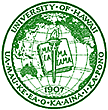
Chancellor advocates
higher UH standardsTougher admissions will create
a challenging environment,
UH-Manoa’s Peter Englert says
The University of Hawaii's Manoa campus should have tougher admissions standards, says a top UH official who has created a task force to study the issue.
"The admission standards that we have are very low," said UH-Manoa Chancellor Peter Englert yesterday in a conference with a handful of faculty members.
"When you have higher standards and a more challenging environment, it's not less students who want to come, it's more students who want to come," he said.
A task force of professors and administrators was formed earlier this year to look at the issue and its impact on potential Manoa applicants, the campus and the system.
By early next year, the committee is expected to share its findings with Englert and members of the Faculty Senate, who would then bring the issue to the full faculty.
But Alan Yang, the university's dean of students, said raising admission standards could close the only research university for 2,500 miles to a number of Hawaii at-risk students, including those with low incomes or moderate English skills.
The standards that exist "deliver a balance of access and student diversity while ensuring a well-prepared student," he said in a phone interview.
He said the current standards are comparable to other peer institutions, including the University of California at Davis, the University of Oregon and Colorado State University.
Students admitted into the Manoa campus are currently required to have at least a 2.5 GPA and an SAT score of 1020. The Board of Regents would have to approve a change in admission standards.
The debate on whether to raise admission standards at Manoa -- and move those who are unable to meet them to other four- or two-year UH campuses -- began to gain momentum among administrators last year with the creation of a strategic plan for the campus. The plan included a commitment to increase academic rigor for Manoa's undergraduates.
About a dozen faculty members and administrators met with Englert yesterday afternoon at the Manoa campus in an open session that was aimed at addressing concerns brought up in a recent Faculty Senate session. Also discussed was the quality of both graduate and undergraduate education at Manoa.
Englert said raising the standards would mean incoming students would be expected to have a greater breadth of knowledge.
Most of the faculty members at the conference -- all of whom were either Faculty Senate executive members or senators -- largely agreed.
Some also said that too much remedial teaching is being done at Manoa.
"We can cater to someone shopping around trying to find the lowest standards, or we can cater to someone shopping around trying to find the highest," said UH-Manoa philosophy professor James Tiles.
The talk of stricter standards comes as enrollment at all 10 UH campuses continues to grow and is expected to increase again next fall by about 3,000 students, Englert said.
About 14,000 of the UH system's roughly 20,000 students attend UH-Manoa.
"If we have an opportunity for 6,000 to 9,000 to go to another part of the system, we would not have to carry the burden we are now," Englert said.
Having fewer students on campus could improve undergraduate education by down- sizing classes and increasing access to programs and facilities, he said.
And, he said, higher standards and higher prestige could also mean higher tuition.
But Yang said that UH-West Oahu, the only other four-year public institution on the island, cannot be used as an alternative to Manoa. Neither can UH-Hilo or any of the system's community colleges.
"While students might be able to attend those, the kind of experience that they derive" will be different, he said.
Karl Kim, the university's interim vice chancellor for academic affairs, said raising standards could also mean decreasing the diversity of the student population.
Englert, though, contended the university can raise standards and maintain student diversity.
